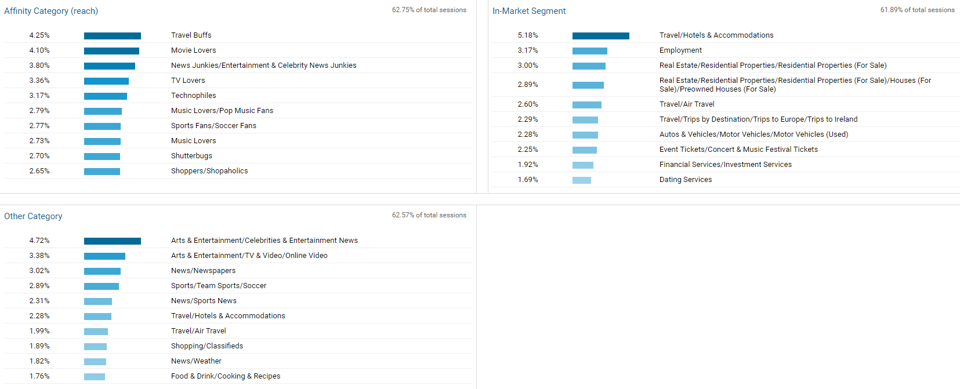See no evil, hear no evil – why analytics matter

Posted by Greg McLoughlin
January 24th, 2017
In the early days of marketing, it was a challenge to know if your strategy was actually delivering the results your business wanted.
Traditional forms of advertisements like newspapers, glitzy billboards, radio and television always struggled to give marketers any real insight into their figures. Sure, so many people saw the ad - but how many were acting on it? What was actually driving the purchase decision?
But those days are long gone.
If the good old days had an automobile equivalent, it'd probably be a Toyota Corolla; a simple, bottom-of-the-line car with no bells and whistles that gets you from A to B in good time. The journey always had a few bumps but it did the job.
Nowadays, we're driving a kitted-out Jaguar. The digital age has given us every single thing we need to get our strategy over the line and delivered in style. And solid data and analytics is the essential ingredient that keeps that beautiful motor running.
Marketing analytics tools now act as the fuel that informs our strategy so that we're always getting the most out of our marketing efforts. But even then, marketers are struggling to measure the effectiveness of their content.
In fact, according to HubSpot's State of Inbound 2016 report, 46% of marketers cited "proving the ROI of our marketing activities" as one of the biggest challenge they face within their company.
Every time I see a happy-go-lucky marketer using their 'best' judgement to indicate whether any of their strategy is actually working, it breaks my heart into tiny little pieces. A little Tommy Wiseau moment is imminent. God dammit, you are tearing me apart *insert name here*!

Not using analytics is like kicking a football towards a goal, looking away and giving your team a hesitant thumbs up with a crooked smile. And not actually measuring your efforts makes it a hell of a lot harder to achieve the goals you want so you can improve along the way. So how do we make sure that we're following the right steps to get that ball in the net every time?
Using the SMART goals methodology will cover everything to make sure your strategy is at its most efficient.
SMART is an acronym for Specific, Measurable, Attainable, Relevant and Timebound and it's designed to ensure that you're always ticking the right boxes before you execute your strategy.
If you're new to the analytics train, here are some essential tools to get you started.
Google Analytics
If you want to create content to drive visitors to your website and generate leads, using a tool like Google Analytics can give you unlimited benefits.
Google Analytics has become the quintessential analytics tool for marketeers. Simply create an account, install the code and it'll start collecting data from your website for you to sink your teeth in to.
Once you've built enough data, you'll get an insight into exactly what your audience are doing on your website. Get audience breakdowns on demographics and interests through affinity categories to get one step closer to your personas. From here, you can can create the most relevant content for your audience.

You can also see which channels (direct, organic search, paid search, social and display) are performing best for your website and exactly what pages are gaining traffic. Valuable metrics like sessions, new users, unique page views, bounce rate and pages per session will help you get under the hood of your website. You'll be able to understand what pages are performing and, most importantly, drive the results you want.
Set up goals so you can track online conversions and show ROI for your marketing efforts. The dashboard may take a little time to get to grips with, but feel free to use the Google Analytics Help Centre to guide you through everything.
Better yet, Google Analytics Academy has a set of courses that you can do to get the most out of the tool. You also get a shiny certification that you can add to your LinkedIn should you pass the exams. Best of all, it's all free.
HubSpot
If you want to take it all to a whole new level, using Inbound Marketing software like HubSpot will allow you to delve deeper into your audience and bring your efforts one step closer to success. HubSpot have been pioneers in bringing Inbound Marketing to the masses and using the powers of content to nurture your audience down the funnel to convert.
Use it to publish blogs, house big-rock pieces of content and create landing pages to convert unknown visitors into qualified leads. From there, you can segment your data in any way you please and create automated email workflows to nurture your leads through the buyer's journey and convert.
You'll also get a detailed breakdown on how every single lead is engaging with your website once they give you your name and email through a form on your website. It also tracks their IP address once before they actually convert, so you'll get all of their prior activity before they converted. It's all very spooky and amazing at the same time.
These are just 2 of the tools we use in our day-to-day for analytics. Saigo George, an SEO consultant from Australia, has an endless list of tools for all of your marketing needs. Feel free to try some out and see what works for your business. :)
Always remember, the more factual data you have about your audience and how they're engaging with your content, the harder it will work for you. Playing the guessing game simply won't work. Measuring your progress is the only way your strategy will have as much focus as possible to give you the info you need to iterate and improve.
"Without continual growth and progress, such words as improvement, achievement, and success have no meaning" - Benjamin Franklin.
Ah Ben, you always had a way with words.

Greg McLoughlin

Previous Post
Content Marketing Trends for 2017 that you need to know
Next Post

How to optimise your content for featured snippets
Subscribe Here
You may also like...
Nicole Thomsen | Dec 11, 2023
Nicole Thomsen | Nov 6, 2023
Nadia Reckmann | Nov 2, 2023





